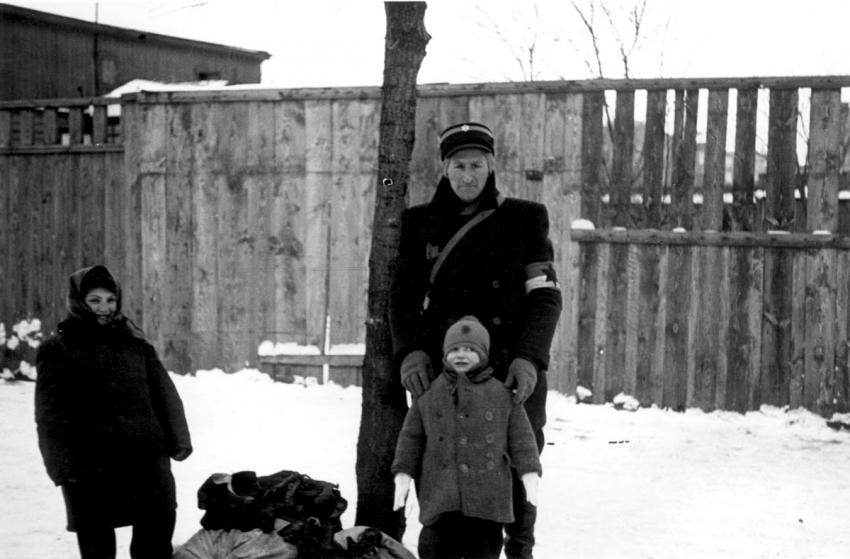In December 1941, the Germans ordered the head of the Judenrat in the Lodz ghetto, Mordechai Chaim Rumkowski, to supply them with 20,000 Jews. They did not specify their destination. After Rumkowski asked for a reduction in the number of deportees, the Germans agreed to deport "only" 10,000 Jews from the ghetto, but when the deportations commenced, they reneged and demanded more Jews.
On 16 January 1942, the mass deportation of the Jews of the Lodz ghetto began. The first wave lasted for two weeks, in the course of which some 10,000 Jews were deported. They were gathered at the Radogoszcz railway station inside the ghetto, and from there were deported to the Chelmno extermination camp.
A further wave of deportations began on 22 February, in the course of which some 3,000 Jews were deported. This wave ended in early April. No one was aware that the deportees were being sent to the Chelmno extermination camp. In the first wave, the deportees were allowed to take 10 marks with them. In the second wave, even this paltry sum was not permitted to them.
On 8 February, Rumkowski delivered an address at the conference of factory managers in the ghetto. He claimed that a work permit constituted security for the ghetto inhabitants and thus stressed the importance of work in the ghetto as a means to survive. Work assumed critical importance, especially in light of the uncertainty surrounding the deportations, their timing, scope and target population.
In February and March 1942, writers of the Lodz Ghetto Chronicle reported on over 20 suicides of ghetto inmates, who had taken their lives due to, inter alia, the loss of their relatives, stress, starvation, sickness and anxiety regarding the future. They committed suicide by hanging themselves, slitting their wrists, ingesting poison or jumping off tall buildings and bridges in the ghetto.
At the end of March, the weather turned extremely cold. A writer of the Chronicle reports:
"Many of the deportees froze with cold while still at Radogoszcz station waiting for the train. In the course of the deportation, five corpses of deportees who had presumably frozen to death at the very start were brought to the ghetto."
In addition to the Jewish deportees, Roma were also deported from the ghetto. In October and November 1941, the Nazis had placed some 5,000 Roma in the Lodz ghetto. Many perished due to the deplorable conditions, and the rest were deported to Chelmno in early January 1942.
In October and November 1941, approximately 20,000 Jews were transferred to the ghetto from Germany, Austria, areas of Bohemia and Moravia annexed to Germany (later Czechoslovakia) and Luxembourg. Most of these Jews were over 50, and they perished there at twice the rate of the other inhabitants: 16% of them died within six months. In May 1942, the Germans sent another 10,000 of them to Chelmno.
From January until May 1942, 55,000 Jews were deported from the Lodz ghetto to Chelmno. In a further wave in September 1942, over 15,000 more Jews were deported, such that by the end of 1942, over 70,000 Jews and all the remaining Roma had been deported to Chelmno and murdered.
The photograph shows a member of the Jewish Order Service (Judischer Ordnungsdienst) with two children in the Lodz ghetto, during the period of the first deportations. The Germans ordered the establishment of the Jewish Order Service in specific areas under German occupation. The Jewish councils (Judenraete) in those places tried to supervise the Order Service, to recruit suitable candidates and to establish behavioral norms, but in many cases, the Germans forced them to recruit people who would be prepared to obey orders unquestioningly. Some Jews saw the Order Service members as outsiders who constituted a danger to the community.
The deportations affected every Jew, including the families of the policemen, and the members of the Jewish Order Service were forced to make a difficult choice. Some abandoned the Service, even though it meant deportation to the death camps with their families, so as not to be part of the roundup of the ghetto Jews. Others continued to follow German orders, in the hope that roundups could be carried out in a more humane manner than would be executed by the Germans, and thus lives could perhaps be saved, at least at this point.
Yad Vashem Photo Archives, 1602/292







